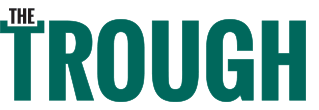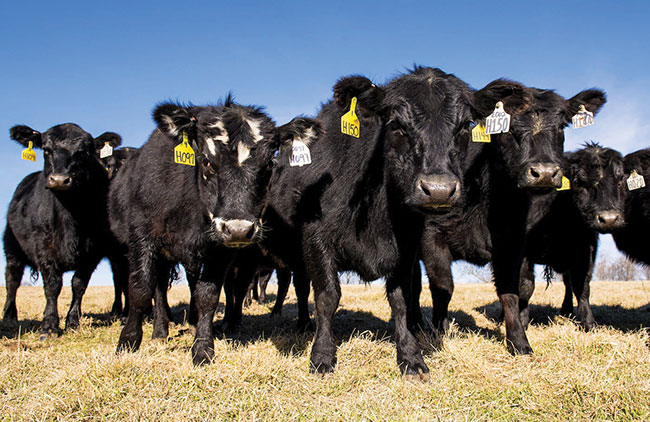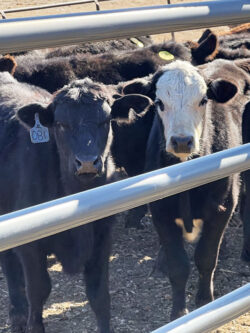
Features
Business
Top animal health story of 2023: Feeding high-risk cattle
By James Careless
New research shows limit-fed diets can work
 Historically, many have believed that high-risk cattle need a high level of roughage in their diets, which can be expensive.
All images courtesy of University of Arkansas/Daniel Rivera
Historically, many have believed that high-risk cattle need a high level of roughage in their diets, which can be expensive.
All images courtesy of University of Arkansas/Daniel Rivera Good news for cattle farmers: “High-risk cattle” can be raised on a cost-effective “limit-fed” diet just like “low-risk cattle”, without the cows suffering negative health effects.
That’s the finding of a recent study by the Arkansas Agricultural Experiment Station, the research arm of the University of Arkansas System dvision of agriculture. This means any high-risk cattle they acquired can be fed the same way as “low-risk cattle”, saving farmers money without compromising on growth goals.
For the record, high-risk cattle are typically calves with no history of vaccinations, or any history at all. They can also be young cattle who have been transported for an extended period of time, and/or mixed in with other lots at a sale barn.
In contrast, low-risk cattle have undergone a preconditioning period with vaccinations from youth. Yearling cattle from a single source with a known health record are also considered to be low-risk of suffering adverse health effects from limit-fed diets. “Historically, we’ve always thought that high-risk cattle – because they’re coming from a ranch or a farm where they were typically fed roughage – need a high level of roughage in their diets before being transitioned to a more energy-dense diet as they go through their pre-conditioning process,” says Daniel Rivera, the Experiment Station’s associate professor of Animal Science. Rivera is the director of the division of agriculture’s Southwest Research and Extension Center in Hope, Ark. where this study was done.
“Unfortunately, roughage is more expensive to feed cattle on a per-unit of energy or protein basis, compared to some of the diet concentrates, but with high-risk cattle we’ve always felt that this is a necessary evil.”
The study
As documented in the Arkansas Agricultural Experiment Station online report, “Study Shows No Negative Health Effects on Limit-Fed Diet in ‘High-Risk’ Cattle”, the study fed three groups of high-risk cattle in three different ways. Starting in January 2022, the control group was fed two per cent of their body weight in grain and grain by-product pellets plus free access to Bermuda grass hay. The second group was “limit-fed” grain pellets at 1.75 per cent of their body weight, while the third group was limit-fed in the same manner, but received grain and grain by-product pellets at 2.25 per cent of their body weight.
The study ran over 63 days, and was conducted using 168 yearling cattle in total. The average weight of the cattle — half of which were bulls requiring castration while the other were steers — averaged 470 pounds each. They were purchased from sale barns in Arkansas and Texas.
“The cattle were randomly assigned to pens in groups of seven,” says Rivera. “We measured their body weights when they first came in, and that was the body weight that we used to develop the amount of feed based for all three groups. “In all cases, the animals were fed twice a day once in the morning around eight o’clock, and then sometime around one or two in the afternoon. Any animals that were displaying symptoms of respiratory disease and a temperature above 104 degrees Fahrenheit were removed to different pens, treated with, then returned to their home pens and original.”
During the study period, all 168 cattle underwent the same two-month preconditioning phase. This included the yearlings being vaccinated against respiratory and clostridial pathogens, plus deworming, treatment with long-acting antibiotics, and receiving growth-promoting implants.
“All were weighed on days zero, 21, 42, and 63 before being shipped to a commercial feedlot in New Mexico where they were adapted to a growing diet and then a finishing diet,” says Rivera.
Positive results
Based on the cattle weigh-in results, the study’s researchers found that the control group cattle (fed 2.25 per cent of their body weight in grain pellets daily plus free access to hay) and the group limit-fed 2.25 per cent of their body weight in grain pellets daily and no hay both experienced average weight gains of about 2.8 pounds daily. In contrast, the group being limit-fed 1.75 per cent of their body weight in grain pellets daily and no hay gained slightly less than two pounds per day.
At the same time, none of the three groups showed any significant signs of rumen distress due to their diets, nor was the level morbidity from bovine respiratory disease significantly higher in one group compared to the other two. In fact, the only noticeable difference was based on the amount of grain pellets fed daily to the two no-hay groups, and their resulting weight gain over 63 days.
For Daniel Rivera and his research team, these results challenge long-held beliefs about high-risk cattle that have been costing cattle farmers extra money in roughage for decades. “For the past 50 [to] 60 years, it has been conventional wisdom that high-risk cattle need to be fed more expensive hay as a necessary component of their diets,” Rivera told The Trough. “Although there needs to be more research done to confirm our results on a broader basis, the initial results we’ve recorded suggest that the conventional wisdom is wrong.”
Implications for Cattle Farmers
This ground-breaking study by the Arkansas Agricultural Experiment Station has serious implications for cattle farmers, all of them positive.

Cattle can be considered ‘high risk’ if they have no vaccination history, have been transported for an extended period of time, or due to other factors
First, not being required to feed high-risk cattle differently than low-risk cattle simplifies operations for these farmers, allowing them to use one common approach instead of two. This saves money – especially due to being able to feed them grain pellets exclusively – and time.
Second, the fact that high-risk cattle do not require special diets makes it easier for farmers to decide whether or not to buy them. Given that high-risk cattle are often cheaper than their low-risk cousins, this can improve the farmers’ bottom lines.
Third, being able to achieve desired weight goals for high-risk cattle using pellets offers a degree of financial security to the farmers who buy them. This too is financial good news. So too is the fact that high-risk cattle who are exclusively fed pellets are not at significant risk of developing stomach problems than low-risk cattle.
“What we fundamentally learned during this study is that we can avoid feeding high-risk cattle hay if their grain pellets are sufficiently high in the right nutrients and byproducts,” says Rivera. “This is important news for cattle producers everywhere.”
Print this page